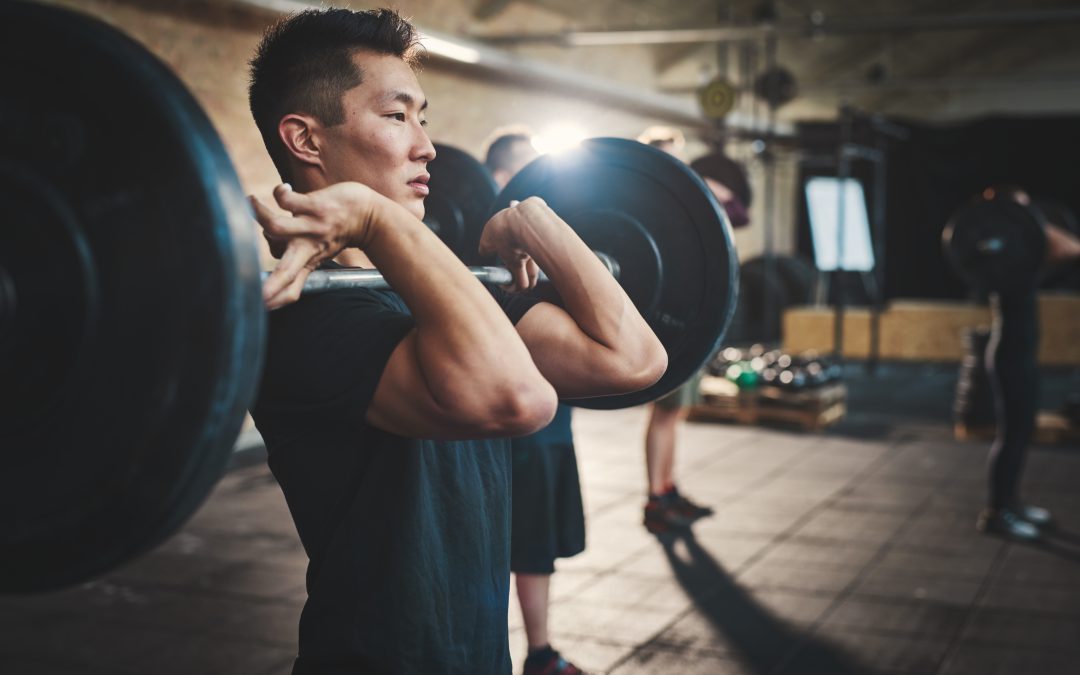A barbell thruster combines two exercises you may already know. The front squat and overhead shoulder press. To get into the start position, hold a barbell on your shoulders and collarbone with elbows high and hands just over shoulder-width apart. Squat down pushing your hips back and knees out so your thighs are parallel with the floor. Then, push back up to the start position and lift the barbell above your head until your arms are fully extended, and return to the start position. That’s one rep.
The barbell thruster is a compound exercise, meaning its multi-joint. You’ll feel it in pretty much all your major leg muscles – so the quads, hamstrings, and glutes. Your abs and back muscles work hard to keep you stable and upright during the exercise, and although it’s your legs that drive most of the force, your shoulders and arms will get a workout too.
How to do a Barbell Thruster?
It’s important that you use proper form and technique when performing thrusters. You can start by using only a barbell. Gradually add weight as you increase your strength, become comfortable with the movement, and are certain you’re using proper form. This is important to avoid injury and gain the most benefits.
Make sure all of your movements are smooth, steady, and controlled. The movement of thrusters should be fluid, quick, and continuous. It shouldn’t be broken into short or separate movements.
Here’s a 5 steps walk through on how to perform a barbell thruster:
- Step 1: Grab a barbell with on an overhand grip that is just outside shoulder-width apart.
- Step 2: Next, clean the barbell up to your shoulders so that your palms are facing the ceiling and elbows are pointing toward the ground. This is the starting position.
- Step 3: Begin exercise by squatting down until your thighs are parallel to the ground and then explode back up as you push the barbell up above your head.
- Step 4: Thrust your hips out as you push the barbell up over your head. Just as you would a deadlift.
- Step 5: End with your arms locked and legs straight. Lower weight back down to shoulder height and repeat as necessary.
The most common mistake made in thrusters is to let the elbows drop from front rack position. This in turn makes the entire upper body tilt forward, shifting centre of balance, and meaning the bar doesn’t just travel vertically – it’ll travel out, too, meaning you use more energy moving through planes. Keep your elbows as high up as your mobility allows to keep the movement smooth and on the vertical plane.
Another issue is turning the thruster into two movements: a front squat, then a shoulder press. The lift should be a smooth movement from the bottom of the squat to overhead, as it’s this momentum that prevent fatigue and ensure you can carry on for the prescribed reps.
What Are the Barbell Thrusters Benefits?
4 Benefits of Heavy Thrusters
The thruster is a total body movement that demands high amounts of force output from the quadriceps, hips, and upper body. In addition to strength, the thruster requires an athlete to be able to progressively accelerate a heavy load so that it has enough velocity to be locked out overhead. By performing heavy (and sometimes moderate to heavy thrusters), you can help to increase leg and upper body power in similar ways to speed squats and push presses.
Core Strength
Heavy lifting tends to develop core stability and strength, regardless of the exercise. Movements that are front loaded, done overhead, or done dynamically further increase these demands from the movement. Heavy thrusters challenge the core, obliques, and erectors in the same way front squats and push presses do, with the added stimulus created by dynamic repetitions that require balance and maximal tension development in the core to support transitions from the squat to the press.
Triceps and Shoulder Strength
Overhead pressing and push presses are great movements for increasing shoulder, triceps, and upper body pressing strength. The thruster is often done with much greater amounts of load. Due to the lifter’s ability to use the low body to assist in accelerating the barbell overhead. The result of such a movement is that the lifter can overload the shoulders and triceps with far greater amounts of volume and load, both of which impact strength and muscle hypertrophy.
Challenges Your Cardiovascular System
Beyond strengthening your muscles, the thruster exercise can also lend to a cardio challenge. Program the movement at high rep schemes or as part of a metabolic conditioning workout or a HIIT workout and you’ll really improve your cardiovascular capacity. Trust, you’ll feel your heart racing and sweat dripping after just a few reps, whether you’re doing a barbell thruster or using other equipment.
The Key Takeaway Points
Overall, the thruster is a great exercise for full body conditioning and developing power. But as with all exercises, there are some scaling options to make the thruster more accessible for beginners, and there are some advanced tips to help you move more efficiently.
If you’re new to thrusters, start with the other options like using dumbbells instead of a barbell and work your way up. Once you mastered with the dumbbells and feel comfortable with them, then that’s the time to try the movement with a barbell.


